GE Logiq P5 Quick user guide

GE Healthcare
Technical
Publications
Direction 5137113-100
Rev. 3
LOGIQ P5/A5/A5Pro

 0459
0459
Quick Guide
Copyright© 2008 By General Electric Co.
Operating Documentation

Regulatory Requirement
This product complies with regulatory requirements of the following European Directive 93/42/EEC concerning medical devices.

 0459
0459
This manual is a reference for the LOGIQ P5/A5/A5Pro. It applies to all versions of the R 3.0.x software for the LOGIQ P5/A5/A5Pro ultrasound system.
GE Healthcare
GE Healthcare: Telex 3797371
P. O. Box 414, Milwaukee, Wisconsin 53201 U.S.A.
(Asia, Pacific, Latin America, North America)
GE Ultraschall TEL: 49 212.28.02.207
Deutschland GmbH & Co. KG FAX: 49 212.28.02.431
Beethovenstraße 239
Postfach 11 05 60
D-42655 Solingen GERMANY
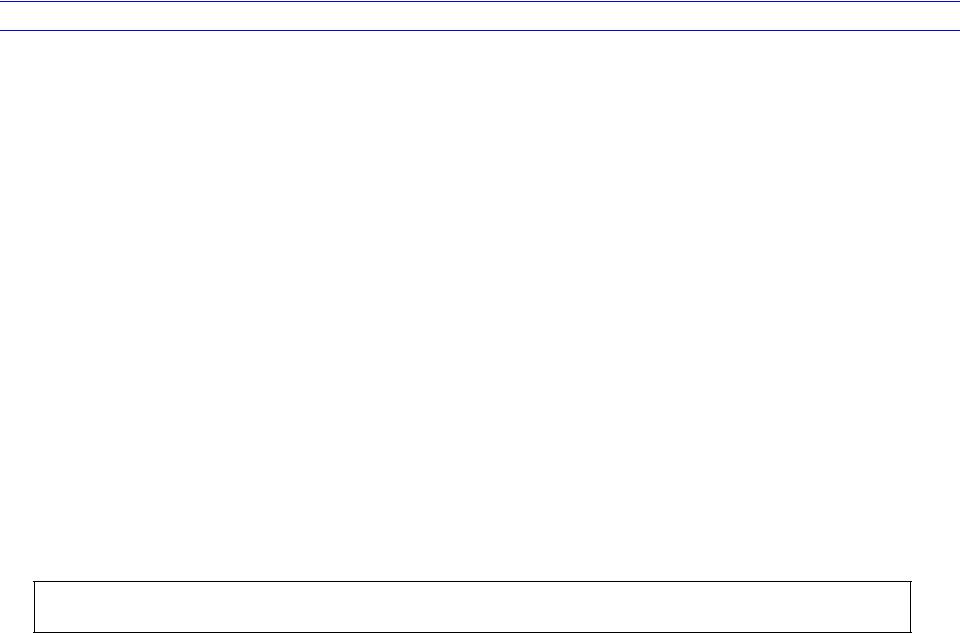
LOGIQ P5/A5/A5Pro Quick Guide |
Direction 5137113-100 Rev. 3 |
A |
Revision History
REV |
DATE |
REASON FOR CHANGE |
1 |
April 18 2007 |
Initial Release |
2 |
May 22 2008 |
BT07 SW Release |
3 |
Dec 10 2008 |
BT09 SW Release |
List of Effective Page
PAGE |
REVISION |
NUMBER |
HISTORY |
Title |
Rev. 3 |
A and B |
Rev. 3 |
1-52 |
Rev. 3 |
Please verify that you are using the latest revision of this document. Information pertaining to this document is maintained on GPC (GE Medical Systems Global Product Configuration). If you need to know the latest revision, contact your distributor, local GE Sales Representative or in the USA call the GE Ultrasound Clinical Answer Center at 1-800-682-5327 or 262-524-5698.

LOGIQ P5/A5/A5Pro Quick Guide |
Direction 5137113-100 Rev. 3 |
B |
|
|
|
CAUTION FOR USA ONLY |
|
|
“United Sates law restricts this device to sale or use by or on the order of a physician” if sold in the United States.
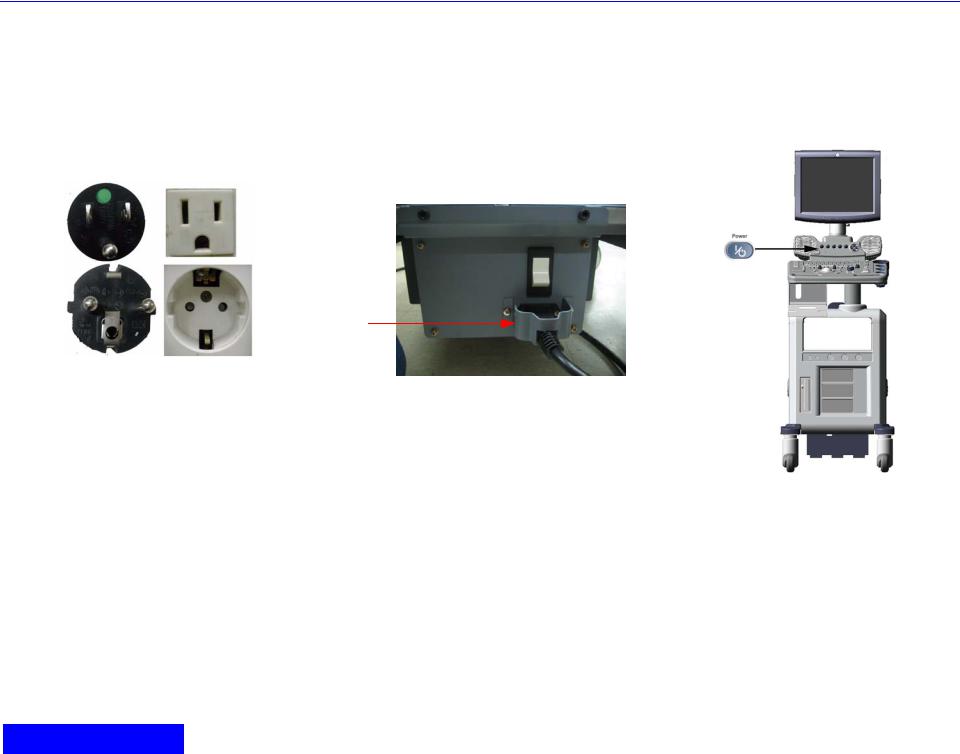
LOGIQ P5/A5/A5Pro Quick Guide |
Direction 5137113-100 Rev. 3 |
1 |
|
|
|
System Power
Power On
To connect the system to the electrical supply:
1.Ensure that the wall outlet is of the appropriate type.
1)
3.Unwrap the power cable. Make sure to allow sufficient slack in the cable so that the plug is not pulled out of the wall if the system is moved slightly.
4.Attach the power plug to the system and secure it in place by using the retaining clamp.
Press the Power switch to turn the power on. The circuit breaker must also be in the on position.
2)
Figure 1-1. Example Plug and Outlet
Configurations
1.100-120 VAC, 950VA
Plug and Outlet Configuration(USA)
2.220-240 VAC, 950VA
Plug and Outlet Configuration (Europe)
2.Ensure that the power switch is turned off.
a.
Figure 1-2. Power Plug
a. Retaining clamp for power plug
CAUTION: Ensure that the retaining clamp for the power plug is fixed firmly.
Use caution to ensure that the power cable does
not disconnect during system use. If the system is Figure 1-3. Power On Switch Location accidentally unplugged, data may be lost.
Preparing for an Exam

LOGIQ P5/A5/A5Pro Quick Guide |
Direction 5137113-100 Rev. 3 |
2 |
Power Off
To power down the system:
1.Press the Power On switch at the front of the system once.
2.The System-Exit window is displayed.
3.Using the Trackball, select Shutdown.
The shutdown process takes a few seconds and is completed when the control panel illumination is power switch is turned off.
4.Disconnect the probes.
Clean or disinfect all probes as necessary. Store them in their shipping cases to avoid damage.
Starting an Exam
You need to select a pre-configured dataflow that sets up the ultrasound system to work according to the services associated to the dataflow.
1.Select your Operator Login and type in your Password:
2.Press Log on.
3.Fill in the New Patient menu as described on Page 3.
OR,
If the patient name is on the patient record list,
1.Trackball to the patient’s name to highlight the name, (or perform a search to locate the patient) then press Select Patient.
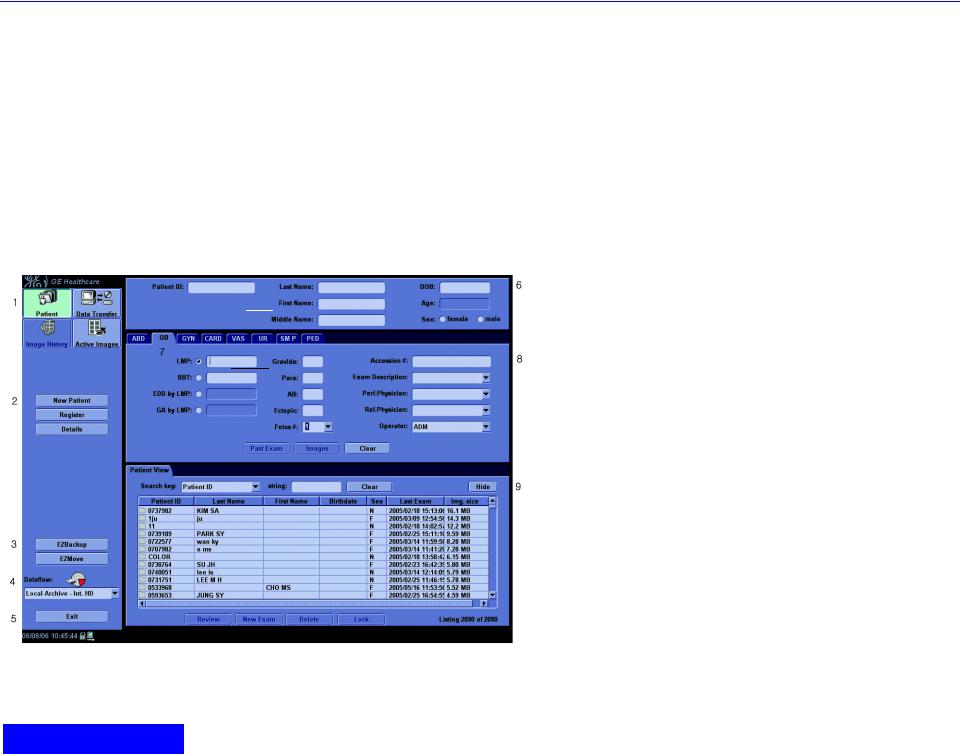
LOGIQ P5/A5/A5Pro Quick Guide |
Direction 5137113-100 Rev. 3 |
3 |
|
|
|
Starting an Exam
New Patient
To start a new patient’s exam,
1.Press Patient. Press the New Patient button on the Patient menu.
2.Select the Exam Category.
3.Type the Patient ID, Patient Name, Birthdate, etc.
4.Press the Register button on the Patient menu (DO NOT press Register if you are automatically generating a patient ID).
5.Press Scan, B-Mode, Esc, or Exit. Select the probe .
Probe Selection
Select a probe (the system automatically selects the lastused application for this probe).
NOTE: You can preset a probe per application or an application per probe via Utility.
Patient Entry Menu (Refer to Illustration)
Image Management Window [1]
Access to this patient’s exam history and image management features.
Function Selection Window [2]
Worklist displays a Worklist screen. New Patient is used to clear the patient entry screen to input a new patient’s data into the database. Register is used to enter new patient information into the database prior to performing the actual exam. Details displays exam details and additional patient information.
EZ Backup/EZMove [3]
One-step method to backup (move and delete patient images) to an external media.
Dataflow [4]
Selects this exam’s dataflow preference.
Exit [5]
Exits the Patient Menu and returns to scanning.
Patient Information [6]
Patient ID, Name, Birthdate, Age, and Sex.
Category Selection and Exam Information [7&8]
Select the appropriate category and enter the exam information.
Patient View and Exam View [9]
Patient View lists the patients in the database. “Search Key” enables searching list by Patient ID, Last Name, First Name, Birthdate, Sex and Last Exam date. “Search key” and “string” fields help define the search parameters.
Exam View lists the exams of the selected patient. Select the patient or the exam in Patient View and press “Exam View” or “Review“.
Preparing for an Exam
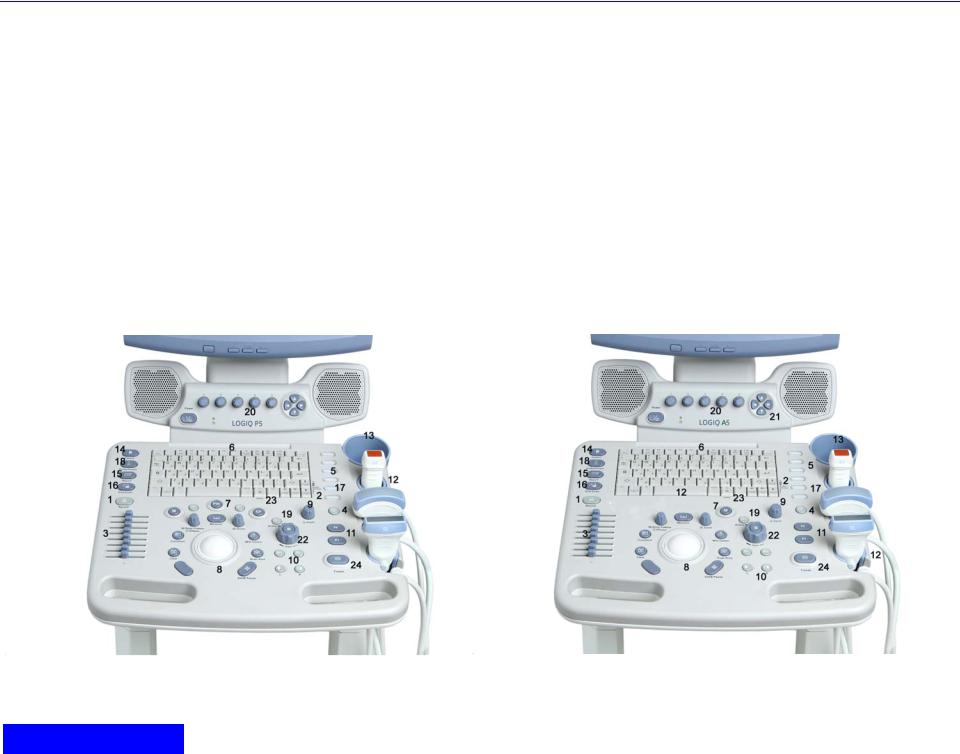
LOGIQ P5/A5/A5Pro Quick Guide |
Direction 5137113-100 Rev. 3 |
4 |
|
|
|
LOGIQ P5/A5/A5Pro Control Panel Tour
1.Record. Press to activate recording devices
2.Audio On/Off and Volume
3.TGC. Move slide pots left/right to adjust TGC.
4.Reverse. Press to invert the image left/right
5.Additional Feature Keys
6.Keyboard : Use the keyboard to enter patient information and annotations.
7.Mode Keys : M Mode, Continuous Wave (CW) and Pulsed Wave Doppler (PW) Modes, Power Doppler Image Mode (PDI), Color Flow (CF)
Mode, B Mode, and B Flow. CW, PW, PDI, CF keys are for LOGIQ P5 only.
8.Imaging/Measurement Keys : Clear, Comment, Body Pattern, Ellipse, Measure, Zoom, M/D, Cursor, Scan Area, Set. Press or rotate these keys, as necessary.
9.Depth : Rotate to adjust the Depth.
10.Imaging Feature Keys : Auto Optimize On/Off, THI, Multi Image Left/Right Select.
11.Print Keys : Press P Keys to archive print or send the image.
12.Probe and Cord Holder
13.Gel Holder
14.Patient: Enter Patient screen
15.Reports: Activates default report and Measurement Selection Menu of report choices.
16.End Exam: Activates Image Management and Touch Panel with end of exam options.
17.User Assigned Utility keys: Activates the configuration system.
18.Probe/Preset keys: Select the application to use and Probe select.
19.Mode Paramenters: To toggle between the Primary menus of different modes
20.Top menu Controls : Activates the changes of functions in the Top menu.
21.Sub menu controls: Activates Sub Menu for Modes and toggles/changes functions.
22.Gain Key
23.Utility key
24.Freeze key: Press Freeze to freeze the image.
Preparing for an Exam

LOGIQ P5/A5/A5Pro Quick Guide |
Direction 5137113-100 Rev. 3 |
5 |
LOGIQ P5/A5/A5Pro Top and Sub Menu Controls
In general, Top Menu Controls are of two types, they are Push & Turn Knobs, Sub Menu is of Paddle Switch type
1.The Paddle Switch is used to select Sub Menu Controls.
2.The Push is used to select Top Menu Controls
3.The Rotate is used to turn on/off or change the parameter selected through Top Menu Controls.
Sub Menu key functions :
1.Up.
2.Increase Value/Next Page
3.Decrease Value/Previous Page
4.Down
1 |
2 |
3 |
4 |
5 |
Top Menu Controls
1
3 |
2 |
4

LOGIQ P5/A5/A5Pro Quick Guide |
Direction 5137113-100 Rev. 3 |
6 |
|
|
|
LOGIQ P5/A5/A5Pro Monitor Display Tour
1.Institution/Hospital Name, Date, Time, Operator Identification.
2.Patient Name, Patient Identification.
3.Acoustic Output Readout, System status (realtime or frozen)
4.GE Symbol: Probe Orientation Marker. Coincides with a probe orientation marking on the probe.
5.Image Preview.
6.Gray/Color Bar.
7.Cine Gauge.
8.Measurement Summary Window.
9.Image.
10.Measurement.
11.Results Window.
12.Probe Identifier. Exam Study.
13.Imaging Parameters by Mode (current mode highlighted).
14.Focus Marker.
15.TGC (not shown on the image).
16.Body Pattern.
17.Depth Scale.
18.Image Management Menu: Menu, Delete, and Image Manager.
19.Caps Lock: On or Off.
20.iLinq icon, and system messages display.(not shown on the image.
21.Trackball Functionality Status: Scroll,
M&A (Measurement and Analysis), Position, Size, Scan Area Width and Tilt.
22.Sub menu
Preparing for an Exam

LOGIQ P5/A5/A5Pro Quick Guide |
Direction 5137113-100 Rev. 3 |
7 |
|
|
|
B/M Mode Image Optimize
Power Output
Optimizes image quality and allows user to reduce beam intensity. 10% increments between 0-100%. Values greater than 0.1 are displayed.
Dynamic Range
Dynamic Range controls how echo intensities are converted to shades of gray, thereby increasing the adjustable range of contrast.
Focus Number and Position
Increases the number of transmit focal zones or moves the focal zone(s) so that you can tighten up the beam for a specific area. A graphic caret corresponding to the focal zone position(s) appears on the right edge of the image.
NOTE: Push key to toggle between Focus Number and Focus Position.
Rejection
Selects a level below which echoes will not be amplified (an echo must have a certain minimum amplitude before it will be processed).
Edge Enhance
Edge Enhance brings out subtle tissue differences and boundaries by enhancing the gray scale differences corresponding to the edges of structures. Adjustments to M Mode's edge enhancement affects the M Mode only.
Frame Average
Temporal filter that averages frames together. This has the effect of presenting a smoother, softer image.
Colorize
Enables gray scale image colorization. To deactivate, reselect a Gray Map.
Gray Map
Determines how the echo intensity levels received are presented as shades of gray.
Rotation (Up/Down)
Rotates the image by selecting the value from the pop up menu.
Frequency
Multi Frequency mode lets you downshift to the probe's next lower frequency or shift up to a higher frequency.
Frame Rate/Resolution
Optimizes B Mode frame rate or spatial resolution for the best possible image.
Anatomical M Mode
Allows you to move the M Mode trace in order to Image difficult -to - reach anatomy.
Sweep Speed
Changes the speed at which the time line is swept.
B Mode Control Panel Controls
Auto Optimize
Automatic Tissue Optimization optimizes the image based upon a specified Region of Interest (ROI) or anatomy within the display.
Zoom
Magnifies a zoom region of interest, which is magnified to approximately the size of a full-sized image. An un-zoomed reference image is displayed adjacent to the zoom window. The system adjusts all imaging parameters accordingly. Press Zoom key to activate. Press right zoom key again to deactivate. Use the Trackball to position the Zoom ROI.
Reverse
Flips the image left/right.
Preparing for an Exam
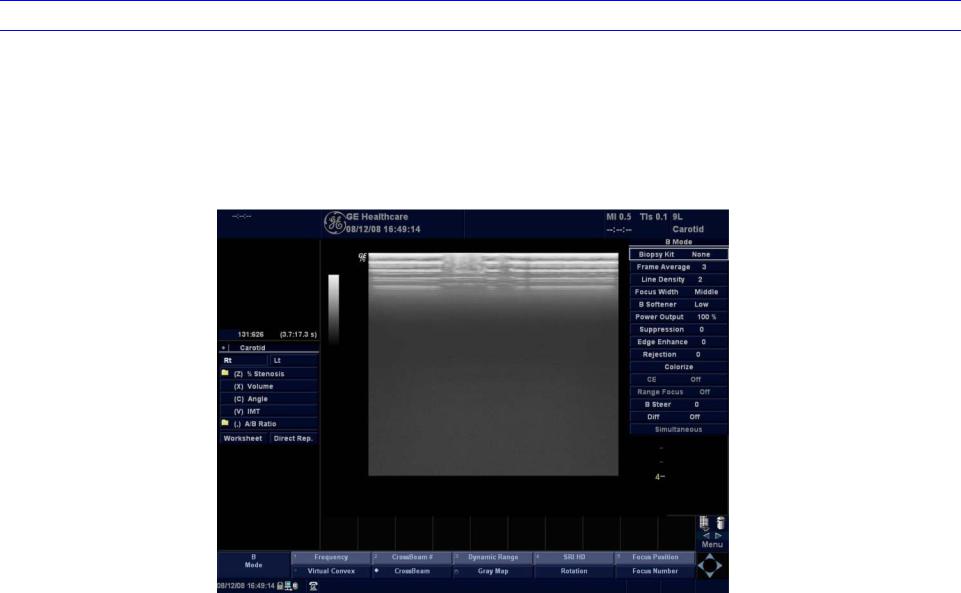
LOGIQ P5/A5/A5Pro Quick Guide |
Direction 5137113-100 Rev. 3 |
8 |
B/M Mode Image Optimize (continued)
B/M Mode Scanning Hints
Auto Optimize. Improves imaging performance while reducing optimization time.
Frequency. Changes system parameters to best optimize for a particular patient type.
Maps. There is an inter-dependency between gray maps, gain, and dynamic range. If you change a map, revisit gain and dynamic range settings.
Dynamic Range. Affects the amount of gray scale information displayed. If you increase the gain, you may want to decrease the dynamic range.
Edge Enhance. Better delineates the amount of border crispness.
Frame Average. Smooths the image by averaging frames. Affects the amount of speckle reduction.
B Mode Top Menu and Sub Menu 1

LOGIQ P5/A5/A5Pro Quick Guide |
Direction 5137113-100 Rev. 3 |
9 |
|
|
|
Color Flow/Doppler Image Optimize
Baseline
Adjusts the baseline to accommodate faster or slower blood flows to eliminate aliasing.
PRF/Wall Filter
Velocity scale determines pulse repetition frequency. If the sample volume gate range exceeds single gate PRF capability, the system automatically switches to high PRF mode. Multiple gates appear, and HPRF is indicated on the display.
Wall Filter insulates the Doppler signal from excessive noise caused from vessel movement.
NOTE: Push key to toggle between PRF and Wall Filter.
Angle Correct
Estimates the flow velocity in a direction at an angle to the Doppler vector by computing the angle between the Doppler vector and the flow to be measured.
Auto Angle
Adjuste the angle to the direction of the Flow.
Angle Steer
Slants the Color Flow region of interest or the Dopple M Line to obtain a better doppler angle.
Threshold
Threshold assigns the gray scale level at which color information stops.
Doppler Display Formats
Display layout can be preset to have B-Mode and Time-motion side-by-side or over-under.
Sample Volume Gate Length
Sizes the sample volume gate.
Map
Allows a specific color map to be selected. After a selection has been made, the color bar displays the resultant map.
Packet Size
Controls the number of samples gathered for a single color flow vector.
Invert
Allows blood flow to be viewed from a different perspective, i.e. red away (negative velocities) and blue toward (positive velocities). The real-time or frozen image can be inverted.
Color Flow Control Panel Control
Scan Area
Toggles between the CFM window size and position.
Controls in Common with B Mode
For more information on Focal Zone, Power Output, FR/RES, Frame Averaging, Dynamic Range, Map, and Colorize, refer to the B/M Mode Image Optimize section in this Quick Guide on Page 6.
Scanning Hints
Line Density. Trades frame rate for sensitivity and spatial resolution. If the frame rate is too slow, reduce the size of the region of interest, select a different line density setting, or reduce the packet size.
Wall Filter. Affects low flow sensitivity versus motion artifact.
To improve sensitivity.
1.Increase the Gain.
2.Decrease the PRF.
3.Increase the Power Output.
4.Adjust the Line Density.
5.Decrease the Wall Filter.
6.Increase Frame Averaging.
7.Increase the Packet Size.
8.Reduce the ROI to the smallest reasonable size.
9.Position the Focal Zones properly.
To decrease motion artifact,
1.Increase the PRF.
2.Increase the Wall Filter.
To eliminate aliasing,
1.Increase the PRF.
2.Lower the Baseline.
Preparing for an Exam

LOGIQ P5/A5/A5Pro Quick Guide |
Direction 5137113-100 Rev. 3 |
10 |
Color Flow/Doppler Image Optimize (continued)
For venous imaging,
1.Ensure that you have selected the small parts exam category.
2.Select a venous application.
3.Select the appropriate probe for very superficial structure.
4.Select two focal zones.
5.Adjust the depth to the anatomy to be imaged.
6.Maintain a low gain setting for gray scale.
7.Activate Color Flow.
8.Maintain the PRF at a lower setting.
9.Increase Frame Averaging for more persistence.
CFM Mode Top and Sub Menu |
PWD Mode Top and Sub Menu |

LOGIQ P5/A5/A5Pro Quick Guide |
Direction 5137113-100 Rev. 3 |
11 |
|
|
|
Basic Measurements
NOTE: The following instructions assume that you first scan the patient and then press Freeze.
Distance and Tissue Depth Measurements
1.Press Measure once; an active caliper displays.
2.To position the active caliper at the start point (distance) or the most anterior point (tissue depth), move the Trackball.
3.To fix the start point, press Set. The system fixes the first caliper and displays a second active caliper.
4.To position the second active caliper at the end point (distance) or the most posterior point (tissue depth), move the Trackball.
5.To complete the measurement, press Set. The system displays the distance or tissue depth value in the measurement results window.
NOTE: Before you complete a measurement:
To toggle between active calipers, press
Measure.
To erase the second caliper and the current data measured and start the measurement again, press Clear once.
NOTE: After you complete the measurement, to erase all data that has been measured to this point, but not data entered onto worksheets, press Clear.
Circumference/Area (Ellipse) Measurement
1.Press Measure once; an active caliper displays.
2.To position the active caliper, move the
Trackball.
3.To fix the start point, press Set. The system fixes the first caliper and displays a second active caliper.
4.To position the second caliper, move the
Trackball.
5.Turn the Ellipse control; an ellipse with an initial circle shape appears.
NOTE: Be careful not to press the Ellipse control as this activates the Body Pattern.
6.To position the ellipse and to size the measured axes (move the calipers), move the Trackball.
7.To increase the size, Turn the Ellipse control in a clockwise direction. To decrease the size, turn the Ellipse control in a counterclockwise direction.
8.To toggle between active calipers, press
Measure.
9.To complete the measurement, press Set. The system displays the circumference and area in the measurement results window.
NOTE: Before you complete a measurement:
To erase the ellipse and the current data measured, press Clear once. The original caliper is displayed to restart the measurement.
To exit the measurement function without completing the measurement, press Clear a second time.
Circumference/Area (Trace) Measurement
1.Press Measure twice; a trace caliper displays.
2.To position the trace caliper at the start point, move the Trackball.
3.To fix the trace start point, press Set. The trace caliper changes to an active caliper.
4.To trace the measurement area, move the Trackball around the anatomy. A dotted line shows the traced area.
NOTE: To erase the dotted line but not the trace caliper, press Clear once. To clear the trace caliper and the current data measured, press Clear twice.
NOTE: To erase the line (bit by bit) back from its current point, move the Trackball or turn the Ellipse control counterclockwise.
5.To complete the measurement, press Set. The system displays the circumference and the area in the measurement results window.
NOTE: Before you complete a measurement:
To erase the line (bit by bit) back from its current point, move the Trackball or turn the Ellipse control counterclockwise.
To erase the dotted line but not the trace caliper, press Clear once.
To clear the trace caliper and the current data measured, press Clear twice.
Preparing for an Exam

LOGIQ P5/A5/A5Pro Quick Guide |
Direction 5137113-100 Rev. 3 |
12 |
Volume
1.To make a volume calculation, do one of the following:
•Make one distance measurement.
•Make two distance measurements.
•Make three distance measurements.
NOTE: Three distances should be done in the dual format mode (side by side images). One measurement is usually made in the sagittal plane and two measurements in the axial plane.
•Make one distance and one ellipse measurement.
•Make one ellipse measurement.
2. Select Volume.
Time Interval Measurement
1.Press Measure twice; and active caliper with a vertical dotted line displays.
2.To position the active caliper at the start point, move the Trackball.
3.To fix the start point, press Set. The system fixes the first caliper and displays a second active caliper.
4.To position the second caliper at the end point, move the Trackball.
5.To complete the measurement, press Set. The system displays the time interval between the two calipers in the measurement results window.
Velocity Measurement
1.Press Measure; an active caliper with a vertical dotted line displays.
2.To position the caliper at the desired measurement point, move the Trackball.
3.To complete the measurement, press Set. The system displays the velocity measurement in the measurement results window.
PI, RI, S/D Ratio, D/S Ratio or A/B Ratio
Select PI, RI, S/D Ratio, A/B Ratio or D/S Ratio from the Doppler Primary & Secondary Controls. Perform velocity measurements.
1.The first caliper is the start point on the Doppler
waveform. This would be VMAX for PI, peak velocity for RI, systole for S/D ratio, “A” velocity for A/B ratio or diastole for D/S ratio.
2.The second caliper is the end-point caliper to the end point of the Doppler waveform. This
would be Vd for PI, minimum velocity for RI, diastole for S/D ratio, “B” velocity for A/B ratio or systole for D/S ratio.
NOTE: For the PI calculation, if Trace Auto is not selected, manually trace the waveform between VMAX and Vd.
NOTE: For the PI calculation, if Trace Auto is on, the system automatically traces the waveform when Set is pressed to fix Vd.
Worksheets
Measurement/Calculation worksheets are available to display and edit measurements and calculations. There are generic worksheets as well as Application specific worksheets. The worksheets are selected from the worksheet button on the screen.

LOGIQ P5/A5/A5Pro Quick Guide |
Direction 5137113-100 Rev. 3 |
13 |
Using Probes
Connecting a probe
1.Place the probe's carrying case on a stable surface and open the case.
2.Carefully remove the probe and unwrap the probe cable.
3.DO NOT allow the probe head to hang free. Impact to the probe head could result in irreparable damage.
4.Turn the connector locking handle counter clockwise.
5.Align the connector with the probe port and carefully push into place.
6.Turn the connector locking handle clockwise to secure the probe connector.
7.Carefully position the probe cable in the probe cord holder spot so it is free to move, but not resting on the floor.
Activating the probe
Press the Probe/Preset button on the front panel.
Move the cursor to the probe icon displayed on the monitor screen and press SET.
The probe activates in the currently-selected operating mode. The probe's default settings for the mode and selected exam are used automatically.
Deactivating the probe
When deactivating the probe, the probe is automatically placed in standby mode.
1.Press the Freeze key.
2.Gently wipe the excess gel from the face of the probe.
3.Carefully slide the probe around the right side of the keyboard, toward the probe holder. Ensure that the probe is placed gently in the probe holder.
Disconnecting the probe
Probes can be disconnected at any time. However, the probe should not be selected as the active probe.
1.Move the probe locking handle counterclockwise. Pull the probe and connector straight out of the probe port.
2.Carefully slide the probe and connector away from the probe port and around the right side of the keyboard. Ensure the cable is free.
3. Be sure that the probe head is clean before placing the probe in its storage box.
Using Probes
